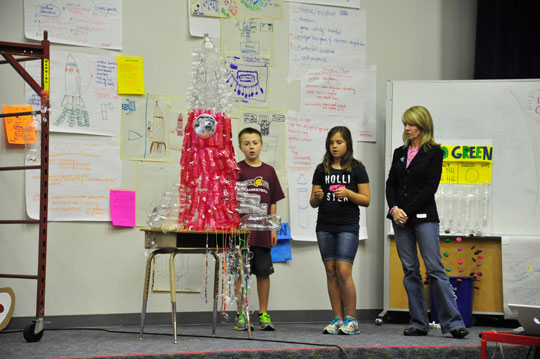A two-week artist in residence program became more than a matter of up-cycling old plastic water bottles.
By Rich Schwartzman
On the surface, it was a simple project, make something out of old plastic water bottles. But, an artist in residence program turned into lessons on creative problem solving for Hillendale Elementary School fifth-graders, according to artist Kathryn McEntee.
McEntee, a sculptor, was this year’s artist in residence at Hillendale. She said of the program, “It was about the creative process that they had to go through and problem solve along the way.”
Her project, she said, was to inspire creativity using nothing but water bottles. Specific projects — chosen by the individual classes — included building a rocket ship, a chandelier and a marble maze.
“We were incorporating the idea of recycling, which is the theme at Hillendale this year for the entire school,” said McEntee.
She added that the fifth-graders were charged with the idea of how water bottles could be used to inspire creativity.
“Everything was completely driven by the kids making choices and doing a lot of creative mind-mapping,” she said, “and pushing themselves to think, ‘Yes, we’d like to do something huge, but what can we actually do?’”
McEntee said the kids rose to the occasion, brainstorming about what water bottles could be turned into, and how it would be inspirational to the younger kids.” She called the project a legacy to the school and younger students.
The students had many discussions to make, based on what money was available to work on a project, how many bottles they had to work with and then dealing with time constraints.
More than 330 plastic bottles were used for the projects. They were cleaned, cut and colored by the students. The total project time was two weeks, but the actual construction time was four days, working one hour per day. Students also had to decide how to divvy up the work among the class members, McEntee said.
“In understanding all those pieces of the puzzle,” McEntee said, “is how they made choices, sometime hard choices because they weren’t what they initially wanted to do. Some of the things they had to learn was there were always more than one right answer and one way to do things and in order to succeed you’re probably going to make a number of mistakes. We were all about trying every idea no matter how crazy it was.”
She said the entire two-week period was about tapping into the creative mind. “What we now know is that 80 percent of creativity is learned.”
McEntee said creativity is a muscle that needs to be exercised like any other muscle. “Every day we did creative muscle-building exercises that would focus them closer to their goals.”
She said the exercises, asking themselves how they would be affected by the project, then asking how other students would be affected, then how it might affect the community.
School Principal Steve Dissinger said the project tied in very well with the theme of recycling, but also connected to upcycling, converting waste materials into new materials or products of better quality or a higher environmental value. He was also impressed with the creative problem solving aspect.
“Everything they used to create their projects were things that we would normally throw into the trash, so there’s the whole upcycling kind of concept behind everything that they’ve done. That’s the recycling piece of it. The other part of it, that is impressive to me, is that it’s not so much the final project that they come out with, but it’s the thought process that they go through…It’s the whole idea of taking something that looks like junk and let’s create a useful product.”
Dissinger said he also liked the idea that while working in small groups, the kids learned to work together even while having different ideas.
There were other lessons learned, according to McEntee. The students learned that it’s not just artists and poets who need to be creative, but athletes and teachers need creativity as well. So do moms and scientists.


 (1 votes, average: 4.00 out of 5)
(1 votes, average: 4.00 out of 5)
Hey I did this project!!!! It was so fun!!! My class made the chandelier. Mrs. MacEntee is sooooooo nice! Oh and they didn’t mention that one class made a paper toss game…